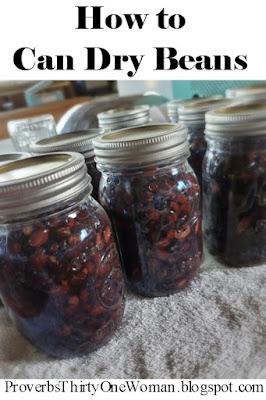Beans are a staple in many households and considered an excellent emergency food to have on hand in case of a natural disaster, loss of job, and so on. These days, I can't eat beans (because they spike my blood sugar badly), but I still have some on hand for my children to eat occasionally. But you may wonder why I bother to can our beans.
Personally, I avoid commercially canned beans because #1, dry beans are less expensive and #2, store-bought beans are less healthy due to high sodium levels and BPA exposure. Still, who doesn't love the convenience of grabbing already cooked beans off the pantry shelf? So home-canned beans it is! (Also, while dried beans last a long time, they do eventually lose their ability to rehydrate; canning our dried beans periodically prevents that.)
The basic method of pressure canning beans (yes, beans must be pressure canned) is the same no matter what type of bean you choose. The method also works great for dried peas (like you'd use in split pea soup). I find that I need about 10 lbs. of dry pinto beans to fill 12 quart jars, about 2 lbs. of dry black beans to fill 8 pint jars, and 4 lbs. of dry lima beans to fill 7 quart jars.
P.S. Some people like to can beans without soaking them overnight first. BUT this is not a tested safe method, so it opens you up to the possibility of food poisoning. Totally not worth the minimal time savings!
How to Can Dried Beans
1. Review the general instructions for pressure canning, if necessary.
2. The night before, pour dry beans into a large pot. Fill the pot with warm water and let the beans soak overnight.
3. The next day, drain the water from the pot. Pour the soaked beans back into the pot and refill the pot with fresh water. Boil the beans for 30 minutes.
4. In the meantime, prepare your jars, lids, and screwbands. Fill your pressure canner with water (according to the manufacturer's directions) and place canning jars inside it. Begin gently heating the water in the canner.
5. Fill a kettle or medium-sized pot with water and bring it to a boil.
6. While waiting for the water to boil, drain the beans. Cover them to keep them warm until the water has come to a full boil.
7. Once the water has come to a boil, remove one jar from the canner, pouring out any water from inside it. Using a ladle, fill the jar with hot beans; a funnel makes this job easier and keeps the jar rims cleaner. (I use this collapsable funnel and this ladle.) Leave 1-inch headspace.
 |
| A funnel and ladle make filling jars easier. |
 |
| Leave one-inch headspace. |
 |
| These are lima beans. |
 |
| Adding salt is optional but recommended for better flavor. |
 |
| Add boiling water but maintain the 1-inch headspace. |
11. Repeat steps 7 - 10 until all the beans are used up or the pressure canner is full.
 |
| Jars in the pressure canner. |
 |
| Lima beans canned and ready for the pantry. |
Fun Variations for Canned Beans
 |
| Pinto beans. |
Molasses or Tomato Beans are a yummy, if a sweet treat.
Molasses Beans: Mix 4 cups water (or cooking liquid from the beans), 3 tablespoons dark molasses, 1 tablespoon vinegar, 2 teaspoons salt, and 3/4 teaspoon powdered dry mustard. Heat to boiling.
 |
| Baked beans. |
For either version, you may also add a 3/4-inch cube of pork, ham, or bacon to each jar, if desired. (Cut off all fat from the meat first.) Then fill each jar 3/4 full with beans and cover with the molasses or tomato sauce, leaving 1-inch headspace. Process pints for 65 minutes or quarts for 75 minutes.
Finally, don't forget baked beans. They are definitely a sweet treat, but fun now and then. Click here for full instructions.
* NOTE: If you live at a high altitude, read this important information about adjusting canning times.
A version of this post originally appeared on this blog in April of 2011.











Great info!
ReplyDeleteJust curious, though... how do the sizes compare for when recipes call for a certain can size when using beans?
I've canned beans also, but I didn't boil them for 30 minutes first. I wonder if that makes a big difference.
ReplyDeleteThanks for the info!
ReplyDeleteI canned 13 pints yesterday and opened a jar to see how they turned out. Fabulous! They are soft, ready to eat, and still hold their form.
For use in recipes measure ounce for ounce. A recipe calling for a 15 ounce can of beans gets nearly 1 pint of home canned beans. But, I wouldn't think 1 ounce of beans would make much difference.)
Thank you! I've been wanting to can my dried beans for ages, but the Ball book didn't have a recipe.
ReplyDeleteOne question- is that time for 10 pounds of pressure?
Well, somehow I've missed all your comments! I do apologize! Liberty, a 1 pint jar of beans is about 16 oz. - about the same as a small can of commercially canned beans. Teekaroo, I've never tried it that way, but certainly the beans do get cooked in the canner. The more you cook 'em, though, the less gassy you'll feel :) Loretta, so glad you are pleased! Lainie, yes, 10 lbs. pressure.
ReplyDelete